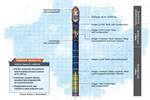Firefly Aerospace performs first flight test of Alpha rocket, ends in explosion
On Sept. 2, the all-composite launch vehicle achieved liftoff and about 2.5 minutes of flight prior to an anomaly resulting in loss of the vehicle.

Photo of Alpha launch vehicle’s Stage One system undergoing static fire tests in 2020.
Photo Credit: Firefly Aerospace
On Sept. 2, (Austin, Texas, U.S.) conducted the first flight test of its all-composite Alpha rocket. According to a , the rocket launched successfully, flew for about 2.5 minutes and achieved supersonic speed, prior to an anomaly that caused the vehicle to explode prior to reaching orbit.
In a LinkedIn post on Sept. 5, the company explained that one of the vehicle’s engines shut down unexpectedly 15 seconds into the flight, and the explosion was caused by a Flight Termination System (FTS). The company says the cause of the engine shutdown is under investigation.
Firefly Aerospace has published a video on YouTube showing the launch:
Firefly’s Sept. 3 statement notes, “While we did not meet all of our mission objectives, we did achieve a number of them: successful first stage ignition, liftoff of the pad, progression to supersonic speed, and we obtained a substantial amount of flight data.” The company says it will release more information as it is available.
Alpha is a two-stage, small-satellite launch vehicle designed to carry 1,000 kilograms of customer payload to low Earth orbit (LEO), and all major structural components are constructed from carbon fiber/epoxy prepreg (read more of CW’s coverage of the composite rocket design). In Oct. 2020, the company announced an investment in an automated fiber placement (AFP) machine, aiming to automate and scale up its rocket production.
Official Statement of our First Test Flight pic.twitter.com/t6QoOmpwrN
— Firefly Aerospace (@Firefly_Space)
Beyond Alpha, Firefly Aerospace has also recently positioned itself to serve other areas of the space market, including the development of a lunar lander with NASA to launch to Mars in 2023, and a new business line launched in August 2021 to supply rocket engines and other spaceflight components to the industry.
Related Content
-
NASA launches composite solar sail into space
Sunlight-based propulsion system, supported by carbon fiber-reinforced booms, will undergo weeks-long testing to demonstrate and verify its capabilities.
-
Near-zero erosion ultra-high temperature CMC
K3RX commercializes UHTCMC for a wide range of markets, demonstrating performance in prototypes, assemblies and advancing manufacturing to reduce cost.
-
Revolutionizing space composites: A new era of satellite materials
A new approach for high volumes of small satellite structures uses low-CTE, low-cost CFRP cellular core, robust single-ply skins and modular panel systems to cut lead time, labor and cost for reflectors, solar arrays and more.
.jpg;width=70;height=70;mode=crop)





